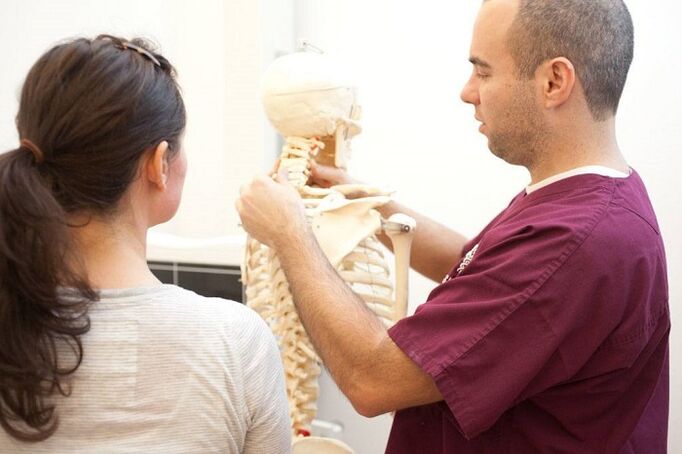Osteochondrosis of the cervical spine belongs to the category of long-term chronic diseases. During the development of the disease, the intervertebral space is destroyed, which, if left untreated, inevitably leads to the formation of a herniated disc. In the modern world, both the elderly and children suffer from osteochondrosis. At the same time, the healing process is delayed for months or even years and does not always guarantee a positive result. Thus, this problem should be taken very seriously, because the sooner the doctor can diagnose the presence of cervical osteochondrosis and prescribe treatment, the better the chances of restoring the patient's health.

There are very characteristic manifestations of this disease, so it will be difficult to ignore them. However, before looking at information on how to diagnose cervical osteochondrosis, it is necessary to learn what its symptoms are and the factors that cause them.
Osteochondrosis is a chronic disease that causes the onset of degenerative processes in the connective cartilage tissue located between individual vertebrae. The development of the disease disrupts the normal functioning of the body and can lead to disability. At the same time, destructive processes cause inflammation that is transmitted to nearby nerve fibers. This development of events leads to muscle spasms, which try to prevent constriction of blood vessels and nerve roots.
However, without external intervention, the body can not cope with the disease, and as a result, the gap between the individual vertebrae, along with other consequences of osteochondrosis, will cause significant circulatory problems and the human brain does not receive enough oxygen and essential nutrients. Of course, this will immediately affect the patient's self-awareness, so osteochondrosis can be identified by a number of characteristic symptoms.
The main symptoms
The most typical symptoms are:
- constant pain in the neck and head;
- regular nausea, sometimes vomiting;
- strong and sudden changes in blood pressure;
- dizziness, fainting.
As you can see, the symptoms are very specific and it is impossible not to notice them, so it will not be difficult to diagnose osteochondrosis in the neck. However, only an experienced neurologist should make a diagnosis, because the disease affects the functioning of many functions, and during the examination it is necessary to draw an accurate picture of what happened to determine the most effective course of treatment.

To determine the nature of the course of osteochondrosis of the cervical vertebrae, the patient is sent for X-ray and computed tomography. In some cases, an ultrasound examination may be scheduled. As a rule, this occurs with complaints of chest pain in the absence of heart pathology.
The manifestation of heart pain in a patient with osteochondrosis of the neck indicates the active spread of the disease along the spine. Such a symptom is rare, so the neurologist will first refer the patient to a cardiologist for examination, who must first diagnose or confirm the absence of heart problems. If the heart system is not affected, there is nothing to worry about, because osteochondrosis itself does not affect the functioning of an important organ such as the heart.
The above symptoms appear in the first weeks of the disease. The only exceptions are dizziness and nausea, as these unpleasant feelings occur in patients in stages 2-3 of the disease.
In general, there are three stages in the development of the disease, the third of which manifests itself in the most insidious way. If you do not treat osteochondrosis of the cervical spine, its severe form will lead to disruption of the normal functioning of many vital systems of the human body.
Prerequisites for the appearance of osteochondrosis
There are many factors that are considered a manifestation of osteochondrosis of the spine in the neck. But the main thing is the wrong position of the spine. For this reason, it is extremely important to develop a kind of habit from childhood to maintain proper body position during work and rest.
The second very important factor is called a sedentary lifestyle. A modern person generally complains about the lack of time for sports, but can also spend a lot of time on the Internet, reckless surfing, idle communication on social networks or computer games.

Since childhood, most people report the great benefits of simple morning exercises. However, few modern people do this, although simple physical exercise in the morning can stimulate blood circulation, experience a real wave of vitality and help to create a good mood for the whole day. In addition, morning exercises will keep your joints healthy and active for many years.
The last serious factor that causes osteochondrosis of the spine in the neck, as well as many other problems, is vitamin deficiency. Usually, the human body is deficient in vitamins in winter and early spring, so during these periods you should eat as many raw vegetables and fruits as possible, or buy vitamin complexes sold in any pharmacy. You should also pay attention to other micronutrients that are important for the body. By the way, many people mistakenly believe that osteochondrosis is caused by calcium deficiency. Although calcium should be used in the treatment of the disease, this is not the case, because it helps cartilage tissue to heal faster.
The main stages of osteochondrosis
- First.In the initial stage, if the human body is rested for a while, a dull pain appears that quickly disappears. In addition, the patient may experience spikes in blood pressure, which is the first sign of oxygen starvation of the brain.
- The second.The next stage is a significant darkening of the normal lifestyle, because the pain syndrome in the neck is quite severe and does not always disappear after taking analgesics. This can be very frustrating, and it can have a detrimental effect on others. In addition, there is a feeling of constant fatigue, systemic headaches appear.
- Third.The last stage is considered the most dangerous. The patient develops unbearable pain in the neck and head, and can not cope even with strong painkillers. Dizziness, nausea are also seen, there is limited movement, and so on.
As you can see, osteochondrosis has a very clear symptomatology, but in the early stages, many people ignore the signs of an impending catastrophe. It is extremely important to be vigilant and identify the disease in a timely manner at the first signs of weakness.
As a rule, patients of the neurologist are people who have already passed to the second stage of development of osteochondrosis. This complicates the treatment process, because the disease can be effectively combated only at an early stage.

Remember that osteochondrosis is one of the most difficult back diseases. It can adversely affect the functioning of several vital systems at once. If you do not seek the help of a specialist in time, you can start a disease that will eventually lead to the formation of a spinal hernia, which can only be corrected by surgery.
In osteochondrosis, the recovery process is delayed for a long time and can only be successful if you strictly follow all the doctor's prescriptions. Under no circumstances should you diagnose or prescribe treatment independently, as you may aggravate the condition.
Many people believe that osteochondrosis is the last resort and it is impossible to get rid of it completely. In fact, this is not the case if the disease has not reached the final stage of development. In other cases, the situation can be corrected, but for this you need to pay attention to the long and hard work, and in addition to change your lifestyle by becoming an integral part of sports and outdoor activities.

























